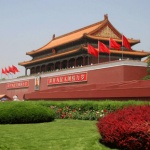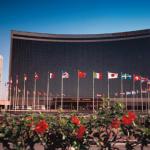Sights Beijing, China
 In the urban area of Beijing dominate three architectural styles. First, is the traditional architecture of imperial China, one of the best examples of which are the Gate of Heavenly Peace (Tiananmen Gate) - an architectural symbol of China and the Forbidden City and Temple of Heaven. The second is the style of 50-70-ies. XX century, which is very reminiscent of the Soviet built the same time. And, finally, modern architectural forms, mainly located in the central business district.
In the urban area of Beijing dominate three architectural styles. First, is the traditional architecture of imperial China, one of the best examples of which are the Gate of Heavenly Peace (Tiananmen Gate) - an architectural symbol of China and the Forbidden City and Temple of Heaven. The second is the style of 50-70-ies. XX century, which is very reminiscent of the Soviet built the same time. And, finally, modern architectural forms, mainly located in the central business district.Amazing mix of old and new architectural styles can be seen in the area known as 798 Art Zone, in which the design of the 1950's merged with the new trends. The influence of American urban forms and social values, there is a suburban settlement of Orange County in an hour's drive north of Beijing.
Beijing's many attractions are concentrated, including members of the world cultural heritage. If you're accustomed to, that "many attractions" refers to viewing a maximum of 3 days, then Beijing will change the way you think about it. Results in the city directory listed 7309 monuments of culture. Of course, not all are equally interesting for tourists, so we list only the most well-known that simply can not inspect:
Tiananmen Square - the main square of Beijing and the largest city square in the world (440 000 sq m). Square of Heavenly Peace used to serve as the main entrance to the imperial palace. The square is the Pantheon of Mao Zedong, where lies the body of the great leader of the Chinese people.
The world's largest palace complex is called the Palace - the Forbidden City. 24 Emperor Ming and Qing dynasties lived here, on a fenced and guarded area, where mere mortals entry was prohibited. Built in 1420, the Palace is surrounded by a high wall and a moat. Trench Width - 52 meters, in Holland he would have considered a large navigable channel! Inside the walls are 9 999 rooms, that only one less than the legend is in his heavenly palace of the emperor. Son of Heaven, the Celestial Emperor, could not be equal to Heaven and had at least one room. Architecture and design are subject to strict order, in accordance with the parties of light according to the laws of Feng Shui.
Inside the station, numerous household items and works of art, transforming the National Palace in a huge museum of the history of imperial dynasties of China. The famous film "The Last Emperor" tells the story of Pu Yi, last emperor of China, indeed, was filmed here.
Of course, the main symbol of China, known, perhaps, all is the Great Wall of China. This fundamental structure according to the Chinese chroniclers had a length of 10 000 there, or about 5000 km. Idiomatic expression "10 000 I" serves not so much an accurate measure of length, as an analog of the expression "very, very much." Modern methods have clarified the total length of all walls - 6 350 km, which is more than 10 000 Do. (Incidentally, the magic number of 10 000 had its own designation of "Wan"). On the wall within sight of each other are watchtowers, gates. Relationship between garrison was carried out using smoke signals or drums.
It is interesting that originally built the wall (and only had three major phases of construction) to serve not so much protection from the raids as "fence" to the young people of the united state does not spread over the plain, and not mixed with the nomadic tribes.
Around Beijing, 75 kilometers is well conserved Zastava Badaling, who served as the main crossing point of the Wall in the capital. It is located at high altitude and was impregnable to the enemy. Keep in mind that walking on the wall in this area require uncommon physical training, because the terrain is mountainous, and you have to climb a good thousand degrees.
If you want to comfortably observe the achievement of Chinese builders, visit the outpost Mutyanyuy where there is a funicular. Temple of Heaven - the place where emperors prayed for good harvest and sacrificing to Heaven. Built in 1420, the Temple of Heaven represents a masterpiece of architecture, from which we can not tear his eyes.
The Beijing Zoo is located on the street Sichzhimenvay-Dazu Rock Carvings Sichenskogo district, covers an area of 50 thousand square. m. In the zoo there are pavilions, which includes rhinoceroses, hippopotamuses, lions and tigers, deer, etc. presents valuable animals: Giant Panda, Manchurian tigers, golden monkey, moose. Mainly represented almost all of the most characteristic species of fauna of different continents. In all there are 490 species, about 5 thousand. Beijing Zoo - the largest in China.
Beijing Botanical Garden is located in Haydyanskom area between the Fragrant Hills Park and Mount Yutsyuanshan, covers an area of 599,400 sq. m. In the botanical garden, in addition to receiving visitors, conducting research and to disseminate scientific knowledge. In the Garden collected more than 3 thousand species of plants, including more than 1500 copies of tropical and subtropical plants, which built a special heated room. Botanical Garden is divided into zones: a zone of plants, the zone of cultural monuments, nature reserve zone and a zone of scientific experiments.
Beijing Opera - one of the most famous arts in Beijing. Beijing opera is considered one of the major achievements of Chinese culture. It is a combination of songs, dialogues and action scenes, consisting of gestures, movements, fighting techniques and acrobatics.
Much of the dialogue sounds of Beijing opera scenic archaic dialect, which is quite distinct from Mandarin, and on the Beijing dialect, it creates serious difficulties for its understanding, even for native speakers. Because in many theaters of Beijing Opera is now installed electronic scoreboards that display captions in Chinese and English languages.
Nightlife in Beijing is rich in various amusements. Most nightclubs are located in the Sanlitun area of the street or near the stadium workers, to the north and west of it. Nightlife can also be observed in the area Udaokou, in the north-west of Beijing. Basically it is visited by Koreans and other foreigners, mainly students.
Hotels
In the two decades after the founding of the PRC in 1949 in Beijing, there was virtually no hotels in the Western sense of the word. Accommodation for visiting at the time provided so-called chzhaodayso - guest houses, answerable directly to a particular agency or public authority. Some of them are used to this day.
In the late 1970's was launched reform and opening up policy, Deng Xiaoping, and for attracting and servicing international business has begun construction of many hotels and other tourist inrastruktury. To date, Beijing is one of the most visited cities and important economic, political and cultural centers of Asia, the city operates a huge number of hotels, many of which correspond to the highest international standards.
The most famous hotel is the State Hotel Beijing. Among other famous hotels Great Wall Sheraton Hotel, Kempinski Hotel Beijing Lufthansa Centre, Jianguo Hotel, Raffles Beijing Hotel, China World Hotel, St. Regis, Grand Hyatt at Oriental Plaza and the Peninsula Palace Hotel, managed by the Hong Kong Peninsula Group.
Youth hostels in recent years are becoming increasingly popular throughout the world, including in Beijing. Most of the hostel is located on the eastern segment of the Third Ring Road or in the city center in the old hutongs.
Shopping
Beijing provides unlimited opportunities for shopping. The main thing in this process - not to get lost in the maelstrom of shops, markets, shops and huge shopping centers. Error was to assume that the goods are sold everywhere only local brands - no, all the world's leading brands are represented, because they are often produced in China.
It is worth mentioning such well-known shopping districts, as Vanfutszin street, department store "Shidou and Dunansky market area of 100 000 square meters, where you can buy absolutely everything.
All day long you can hold on Sidanskoy street where concentrated a lot of shopping and entertainment facilities. Clothes, shoes and silk, worth seeing on the street Syushuytsze, where many small shops are concentrated. Here, the buying process involves bargaining with the seller and a good discount will be your reward for your skills.
Street Lyulichan specializes in the trade in antiques and traditional China-sky art. Here you can buy ceramic plates on which the master can write your name, beautiful examples of calligraphy and other souvenirs.
